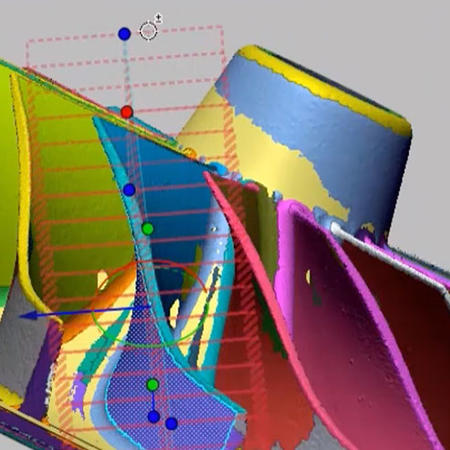When small business owner Matthew Percival of 3D Rev Eng was contracted by Dependable Industries, a pattern and tooling shop in Vancouver, British Columbia, to assist in the reverse engineering of a power generation Francis Runner casting, the full power of Geomagic Design X was put to the test.
Percival had a very finite, one-day window of time to 3D scan the part. There was no drawing to confirm against, so he had to be able to work quickly and accurately. The working runner that was being reversed engineered was on its last repair cycle and needed to have a replacement casting ready in one year. The scan data was acquired in about four hours using a hand held scanner.
The deep narrow pockets of the hydraulic passages limited the scanner’s range and made complete data acquisition impossible. With about 85% of the part scanned, Percival knew he had enough to make a complete CAD model using the software from 3D Systems.
CAD model using the software from 3D Systems.
“For me, Design X is the obvious software choice. The ability to generate solid models directly on the scan data is priceless.”
- Matthew Percival of 3D Rev Eng
Using the data live on site, Percival was able to create sketches and smooth lofted surfaces between the two sides of the acquired data and conform it to the casting using hands on methods in Geomagic Design X. Doing this revealed a number of interesting details to the customer:
- The center axis of the impeller was no longer square to the
vanes which results in an unbalanced and inefficient part - The cast surfaces were badly worn and out of typical tolerance
- The volume of each cavity was inconsistent
Design X easily overcame these issues. Percival was able to generate sketches on the blade, as well as an accurate smooth surface that he could revolve around the extracted revolution axis. The surface was then trimmed to match the profile and revolved to obtain the proper count of blades. Comparing this data live with color deviation maps to the scan data, Percival was able to ensure that accuracy was within the client’s requirements.
The problem of the part not being on the center axis was easily fixed, since Design X allowed Percival to redesign with design intent. He was able to model the part by extracting the profile, generating a sketch and adjusting the revolution axis to the proper design intent. Lastly, he merged the model and extracted the radii from the scan data, applying it to every blade. Once the model was complete in Design X, he used the software’s LiveTransfer technology to send the entire feature-based solid model into Solidworks and saved it as a native sldprt file for the client.
Cost savings in decreased downtime of hydro power generation plant
$ 20,000 per day *
Average cost to traditionally reverse engineer a runner
$ 3,800 and 4 days
3D Rev Eng cost
$ 2,500 and 2 days
Cost to manually produce foundry tooling from traditional reverse engineering data
$ 35,000 and 5 weeks
Cost to CNC cut foundry tooling from CAD data made in Geomagic Design X
$22,000 and 3 weeks
Cost savings in finish machining and balancing of a casting made from CNC tooling
$ 3,500
Cost savings and power generation efficiency resulting from highly-accurate hydraulic passages and balancing
UNLIMITED
Conclusion
The successful completion of the Francis Runner project has opened the door for other impeller projects for Percival and 3D Rev Eng. These projects include aquaculture impellers, mining impeller blades and Pelton wheels. Geomagic Design X allows Percival to quickly use complex shapes and surfaces to produce models within hours, which would otherwise have taken weeks.
